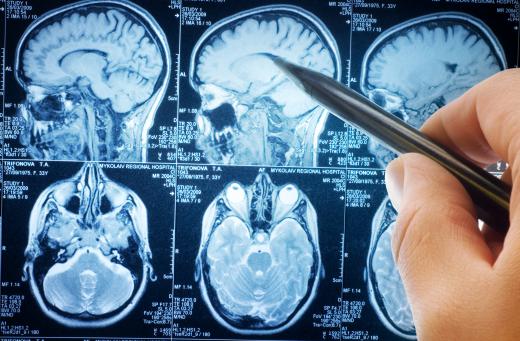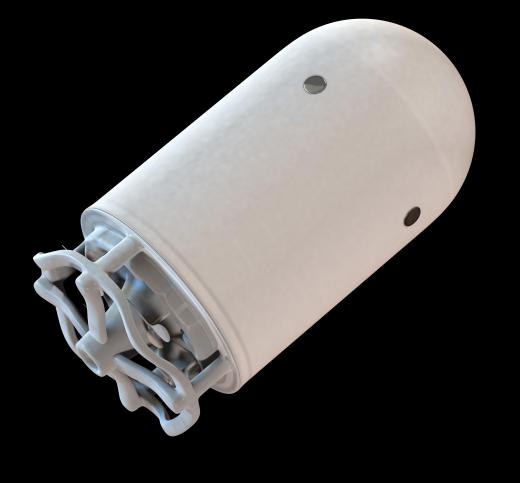What are the Possible Dangers of Nanotechnology?
Researchers have spent a great deal of time and money investigating new applications for nanotechnology, but relatively little has been spent on research into the effects of these particles on human health and the environment. Elements behave differently when made on an extremely small scale, so they may react to their environment in unexpected ways. They may be able to enter the body in ways that they could not before, affecting the brain or other tissues; since many of these elements cannot break the blood/brain barrier when in their standard form, no one really knows what will happen when they do. The shapes of nanoparticles can also be quite different from what is usual for the element, potentially causing living systems to not know how to react to them or to respond negatively.
What Is Nanotechnology?

Nanotechnology is an area of science and engineering that involves the study and manipulation of particles 1-100 nanometers in size. A nanometer is one billionth of a meter, with a meter being about 39 inches. Particles in this size range often have unusual properties, and it is hoped that these can be exploited to bring huge benefits in fields such as science, engineering, medicine, and computing.
The Behavior of Nanoparticles

According to experts, the issue is that elements at the nanoscale behave differently from the larger sized particles in which they are normally encountered. As an example, graphite's properties are well known: it holds specific position in toxicology guidelines and is not considered a hazardous or reactive material under any normal circumstances. Nobel winning physicist Richard Smalley of Rice University discovered carbon nanotubes and fullerenes (buckyballs) — nanoparticles of carbon — that are categorized as forms of graphite due to the way the carbon atoms are arranged. These particles, however, behave in ways unlike graphite, making their classification a potentially dangerous one.

Scientists know that substances become more reactive as their particles get smaller because the surface area is greater relative to the volume, providing a larger surface on which chemical reactions can occur for a given amount of the substance. One example concerns the element iron. An iron nail will not burn, but the same quantity of the element in the form of an extremely fine powder will ignite spontaneously when exposed to air. Similarly, substances that are normally fairly inert may undergo unexpected chemical reactions in the human body or in the environment when in nanoparticle form.
How Nanoparticles Interact with Living Systems

Any assessment of the dangers of nanotechnology is complicated by the fact that the size and shape of nanoparticles may affect their bioactivity and toxicity. As a result, a simple categorization based on the known properties of the elements may not be possible. Their ability to interact with living systems increases because they can often penetrate the skin, enter the bloodstream via the lungs, and cross the blood/brain barrier. Once inside the body, there may be further biochemical reactions, such as the creation of free radicals that damage cells and DNA. Another issue is that while the body has built-in defenses for natural particles it encounters, nanotechnology is introducing entirely new substances that the body would not recognize or be able to deal with.
Sometimes, the physical, as opposed to chemical, properties of particles may alone make them hazardous in unexpected ways. Asbestos is one example. Since it is chemically quite inert, it was initially thought to be harmless and was widely used, but when it is cut or broken, this material produces tiny, airborne fibers that can be inhaled. It has now been established that these fibers can cause cancer when they lodge in the lungs, and it seems that the effect is due to their size and shape, and the way they interact mechanically with lung cells.
One scientific study found that some types of carbon nanotubes closely resemble asbestos fibers in their dimensions and shape, and tests on animals showed that the nanotubes cause inflammation and lesions in tissue exposed to them. No link to cancer has yet been proven, but in the case of asbestos, the disease may only develop several decades after exposure. Today, 3,000 deaths per year are still attributed to asbestos from decades-old use. Those concerned with the possible dangers of nanotechnology hope to avoid a similar or even worse future scenario, especially considering the growing market for nanoparticles in such diverse products as car paint, tennis rackets, and make-up.
Studies on Nanoparticle Effects
In March 2004, tests conducted by environmental toxicologist Eva Oberdörster, Ph.D., of Southern Methodist University in Texas, found extensive brain damage to fish exposed to fullerenes for a period of just 48 hours at a relatively moderate dose of 0.5 parts per million — comparable with levels of other pollutants found in similar environments. The fish also exhibited changed gene markers in their livers, indicating their entire physiology was affected. In a concurrent test, the fullerenes killed water fleas, an important link in the marine food chain.
Oberdörster could not say whether fullerenes would also cause brain damage in humans, but she cautioned that more studies are necessary and that the accumulation of fullerenes over time could be a concern, particularly if they were allowed to enter the food chain. Earlier studies in 2002 by the Center for Biological and Environmental Nanotechnology (CBEN) indicated nanoparticles accumulated in the bodies of lab animals, and still other studies showed fullerenes travel freely through soil and could be absorbed by earthworms. This is a potential link up the food chain to humans and presents one of the possible dangers of nanotechnology.
Other nanoparticles have also been shown to have adverse effects. Research from University of California in San Diego in early 2002 revealed cadmium selenide nanoparticles, also called quantum dots, can cause cadmium poisoning in humans. Cadmium is toxic in any form that can be absorbed by the body, but the tiny size of these particles may increase the risk of accidental exposure. In 2004, British scientist Vyvyan Howard published initial findings that indicated gold nanoparticles might move through a pregnant woman's placenta to her fetus. Even as far back as 1997, scientists at Oxford discovered nanoparticles used in sunscreen created free radicals that damaged DNA.
The Future
There is no doubt that nanoparticles have interesting and useful properties and may bring great benefits, but research into their possible adverse effects is still ongoing, and people are already exposed to them. Workers employed in the manufacture of products containing nanoparticles are most at risk: the US National Institute for Occupational Safety and Health (NIOSH) reports over 2 million Americans are exposed to high levels of these particles, and they believe this figure will rise to 4 million in the near future. A number of groups have proposed a moratorium on manufacturing and marketing of products containing nanoparticles and urge research to precede manufacturing rather than follow it. There are concerns that strong economic drives and competition in the marketplace may be taking precedence over scientific prudence when it comes to public health and the potential dangers of nanotechnology.
AS FEATURED ON:
AS FEATURED ON:














Discussion Comments
Are they putting these nano techs in supplements and drinks and selling them as energy feel gooders and no pain, clear minds? I think they are.
If nano-particles are smaller than usual, then surely we can build something that allows you to breathe underwater?
I got this assignment and would like to know are nanoparticles really dangerous?
No matter how advanced science gets or how far scientists try to tweak existing matter or molecules into other things, they cannot alter the natural order of the Universe.
This is where our creation and our inalienable rights given to us by our natural birth and foundation of our Constitutional Republic gives our safety and the right to not have Frankenstein controllers forcing us to accept their imposed changes to our existing human biology to later control us.
We do not wish to be cows in a stall producing milk for elitists who have managed to already enslave America and the world into their feudalism taking over our bodies, governments and now even our minds. This is junk science and an abomination.
This reminds me of a time when we were on the brink on the internet. People like the unabomber were opposing it and talking about its dangers. Now nobody can live without it. Will all these problems lead to research and development to fix them? Hopefully, judgment day isn't coming.
can't we just the live the way we are bloody living already? Ain't it good enough? if everyone had this attitude, we'd be safe. and we can use all the millions of dollars spent on nanotechnology to strengthen existing food technologies and carry out even more research to make it even more safe. the key factor is safety.
if nanotechnology is going to be used in the future you would really prefer if the world knew more about it! after learning lots about nanoparticles from my 15 year old child's chemistry books i wished i knew about it sooner. nanobots are overrated at the moment as it is something we will face in the future, good or bad.
all the faf about whether it will cause brain damage to humans as well as fish is probably right but we need to face it because it will come with benefits. It will not be the end of mankind. It may lead to diseases but not the end. if you can, please tell me why I'm wrong. i would like to hear it.
anon9263 you have pretty good knowledge about the dangers caused by nanotechnology.I wish to know more about the darker side of nanotechnology. If you could provide me with some suitable sources and advices it would help me a lot.
What about the vitamin drink with nanotechnology in it? won't that method give nanoparticles a clear, concise pathway to the brain through interaction with the cells directly? what kind of effects can this have long term?
My personal opinion is that every new technology can be useful and serve the mankind as long as we use it correctly and get the goods out of it.
"Tune the nanoworld to serve the macroworld."
There was a time when doctors were extolling the benefits of cigarettes. Now, we know they cause cancer, but think about how many people had to suffer and die, how many cover-ups were created to hide the truth, and how many whistleblowers were fired, blacklisted and ridiculed before people finally saw the truth.
Nanotechnology, and possibly also GMOs are thought to cause Magellons and other diseases. It could be decades before we know the truth, and, like the story of Big Tobacco, there will be many denials and cover-ups in the interim.
For my part, I do believe theses technologies are harming human health, and I will do my best to avoid them.
I say better safe than sorry. It is just common sense to be prepared for the worst in case it happens, and if this technology is as dangerous as some believe, there may not be time for Plan B once the genie is out of the bottle.
Let's research it more before adding this to food and sunscreens and the rest. Even if it is just an environmental concern, the environment does impact the quality of human life.
i understand that technology goes ahead and we have to accept it but it brings advantages and disadvantages.
Unfortunately companies use it in the worst way to max their profits. i would definitely not want to have nano in my food or drink, or in medicine and cream, but since there is no regulation, it's already there and we even don't know.
so i consider it's inhumane and against our rights, but corporations that support research have no soul.
Would this be plausible?
The DNA of every human being has a unique signature. Nanobots will be able to tell the difference between you and me by querying the DNA in our blood cells. Two sets of programming could be embedded in the darthbots. One program will be to fix and maintain biological systems and the other one will shut down biological systems by masquerading as a disease. The darthbots "Action A you live forever" or "Action B you die" will be based on the host's DNA signature.
The problem is not enough funding is given to research related to human health and safety regarding newly developed science
People laugh and make jokes, but this is a serious issue. At least the questions we ask about nanotechnology and human health are very serious. If we cannot but be cynical when discussing potential destruction of human health, what kind of intelligence do we have. Why must we presume that all technology must be upheld at the expense of human life, even if all of the scientific facts are not "in"? what does that mean anyway??? The atomic bomb was "progressive technology." Life forms are already showing damage after interacting with nanoparticles, Observation and a little hypothesizing would bring one to the same conclusions given the structure and size of these particles, and the nature of human physiology and anatomy. We are self-destructive by default based on unending greed.
Maybe we can hide under a rock or something, after all, nano zombies are afraid of the dark...
We must stop the nano zombies!!!
Nanotechnolgy. The benefits for manufacturing and medical use could be endless but I guarantee you, the biggest budget nanoscience will get will be for military use.
I have bought BIODISC. I want to know is it safe to use BIODISC?? Does BIODISC helps in relieving pain and give energy?
Your comments are, quite frankly, farcical. In what scientific or peer-reviewed literature have you found evidence of your proposed 'zombie state'? As yet, no experimental evidence has been found to implicate that nanoparticles have a) entered the systemic circulation in a substantial amount to travel to the brain, and b) crossed the blood-brain barrier to accumulate and cause cytotoxic effects. It is well documented that nanoparticles generated as a result of the burning of fossil fuels (combustion-derived nanoparticles) can have some cytotoxic effects especially in the pulmonary system, but until more detailed knowledge is generated your claims are laughable at best.
I am interested in the dangers that nanotechnology can cause. Do to some of the things that I have read up on, nanotechnology can and will cause more than just cancer. What about the brain damage that it can cause. I read that nanotechnology can cause what I like to call a zombie outbreak. It takes over the mind and uses the human body like a host. Once the body can no longer be used it tries to take over another body leading to a kind of zombie like state. Even though it might sound far fetched it must also be taken into consideration because of some of the information that I have gathered, it can very possibly resort to the end of mankind.
Post your comments